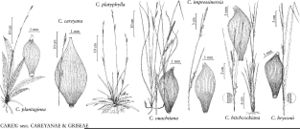Carex platyphylla
Amer. J. Sci. Arts, ser. 2, 4: 23. 1847.
Plants densely cespitose. Culms lateral, ascending, lax, or decumbent, very slender, 14–38 cm × 0.2–0.5 mm. Leaves: basal sheaths white or light brown; sheaths green, lighter to white at base, 1–22 mm; blades erect, ascending, or lax, grayish blue-green, midrib strongly developed, 2 lateral veins developed, 5–22 cm × (7–)11–28 mm, older leaves shriveling or dead at tips. Inflorescences: spikes (2–)3(–4) per culm, scattered; peduncles of pistillate spikes exserted 0–2.2 cm; of staminate spikes 0.1–0.8 cm; bracts from middle and proximal portions of culms 1.4–5.2 cm × 2–6 mm. Pistillate spikes: the proximal basal, erect, 6–16 × 2.8–3.8 mm. Staminate spike 1, linear-clavate, 6–14 × 2–4 mm. Pistillate scales keeled, 3–6 × 1.8–2.2 mm, midribs green, margins hyaline or brown tinged outward, apex apicluate or aristate, awn to 2 mm. Staminate scales obovate, 2.7–5 × 1.8–2.2 mm, midribs green, margins hyaline and brownish to purple tinged outward, apex obtuse to acute. Anthers 3.3–4 mm. Perigynia 2–9 per spike, overlapping, ascending, finely many-veined, obovoid, 3–3.2 × 1.8–2 mm; beak short curved. Achenes ovoid, 2.8–3 × 1.6–1.8 mm, slightly concave at maturity, tightly fitting in perigynia. Style ascending through entire orifice. 2n = 68, 70, n = 32 + (3), 33 + (3), 33 + (4).
Phenology: Fruiting spring.
Habitat: Rich, moist deciduous forests, on rocky or gravelly slopes, soils above limestone, shale, or calcareous metamorphic rocks, often on clay soils
Elevation: 100–1100 m
Distribution

N.B., Ont., Que., Conn., Del., D.C., Ind., Ky., Maine, Md., Mass., Mich., N.H., N.J., N.Y., N.C., Ohio, Pa., R.I., Tenn., Vt., Va., W.Va., Wis.
Discussion
Selected References
None.
